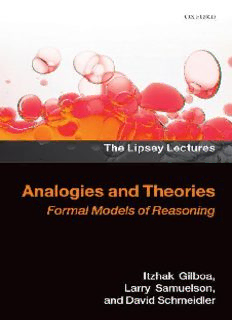Table Of ContentAnalogies and Theories
The Lipsey Lectures
The Lipsey Lectures offer a forum for leading scholars to reflect upon
theirresearch.Lipseylecturers,chosenfromamongprofessionaleconomists
approachingtheheightoftheircareers,willhaverecentlymadekeycontri-
butions at the frontier of any field of theoretical or applied economics. The
emphasisisonnovelty,originality,andrelevancetoanunderstandingofthe
modern world. It is expected, therefore, that each volume in the series will
become a core source for graduate students and an inspiration for further
research.
The lecture series is named after Richard G. Lipsey, the founding pro-
fessor of economics at the University of Essex. At Essex, Professor Lipsey
instilledacommitmenttoexplorechallengingissuesinappliedeconomics,
grounded in formal economic theory, the predictions of which were to be
subjectedtorigoroustesting,therebyilluminatingimportantpolicydebates.
ThisapproachremainscentraltoeconomicresearchatEssexandaninspira-
tionformembersoftheDepartmentofEconomics.InrecognitionofRichard
Lipsey’s early vision for the Department, and in continued pursuit of its
missionofacademicexcellence,theDepartmentofEconomicsispleasedto
organizethelectureseries,withsupportfromOxfordUniversityPress.
Analogies and Theories
Formal Models of Reasoning
Itzhak Gilboa, Larry Samuelson,
and David Schmeidler
1
3
GreatClarendonStreet,Oxford,OX26DP,
UnitedKingdom
OxfordUniversityPressisadepartmentoftheUniversityofOxford.
ItfurtherstheUniversity’sobjectiveofexcellenceinresearch,scholarship,
andeducationbypublishingworldwide.Oxfordisaregisteredtrademarkof
OxfordUniversityPressintheUKandincertainothercountries
©ItzhakGilboa,LarrySamuelson,andDavidSchmeidler2015
Themoralrightsoftheauthorshavebeenasserted
FirstEditionpublishedin2015
Impression:1
Allrightsreserved.Nopartofthispublicationmaybereproduced,storedin
aretrievalsystem,ortransmitted,inanyformorbyanymeans,withoutthe
priorpermissioninwritingofOxfordUniversityPress,orasexpresslypermitted
bylaw,bylicenceorundertermsagreedwiththeappropriatereprographics
rightsorganization.Enquiriesconcerningreproductionoutsidethescopeofthe
aboveshouldbesenttotheRightsDepartment,OxfordUniversityPress,atthe
addressabove
Youmustnotcirculatethisworkinanyotherform
andyoumustimposethissameconditiononanyacquirer
PublishedintheUnitedStatesofAmericabyOxfordUniversityPress
198MadisonAvenue,NewYork,NY10016,UnitedStatesofAmerica
BritishLibraryCataloguinginPublicationData
Dataavailable
LibraryofCongressControlNumber:2014956892
ISBN 978–0–19–873802–2
Printedandboundby
CPIGroup(UK)Ltd,Croydon,CR04YY
LinkstothirdpartywebsitesareprovidedbyOxfordingoodfaithand
forinformationonly.Oxforddisclaimsanyresponsibilityforthematerials
containedinanythirdpartywebsitereferencedinthiswork.
Acknowledgments
Wearegratefultomanypeopleforcommentsandreferences.Amongthem
are Daron Acemoglu, Joe Altonji, Dirk Bergemann, Ken Binmore, Yoav
Binyamini,DidierDubois,EddieDekel,DrewFudenberg,JohnGeanakoplos,
Brian Hill, Bruno Jullien, Edi Karni, Simon Kasif, Daniel Lehmann, Sujoy
Mukerji,RogerMyerson,KlausNehring,GeorgeMailath,ArikRoginsky,Ariel
Rubinstein,LidrorTroyanski,PeterWakker,andPeytonYoung.Specialthanks
are due to Alfredo di Tillio, Gabrielle Gayer, Eva Gilboa-Schechtman, Offer
Lieberman, Andrew Postlewaite, and Dov Samet for many discussions that
partlymotivatedandgreatlyinfluencedthisproject.Finally,weareindebted
to Rossella Argenziano and Jayant Ganguli for suggesting the book project
forusandformanycommentsalongtheway.
We thank the publishers of the papers included herein, The Economet-
ric Society, Elsevier, and Springer, for the right to reprint the papers in
thiscollection.(GilboaandSchmeidler,“InductiveInference:AnAxiomatic
Approach” Econometrica, 71 (2003); Gilboa and Samuelson, “Subjectivity in
Inductive Inference”, Theoretical Economics, 7, (2012); Gilboa, Samuelson,
and Schmeidler, “Dynamics of Inductive Inference in a Unified Model”,
JournalofEconomicTheory,148(2013);GayerandGilboa,“AnalogiesandThe-
ories:TheRoleof Simplicityandthe EmergenceofNorms”,GamesandEco-
nomic Behavior, 83 (2014); Di Tillio, Gilboa and Samuelson, “The Predictive
RoleofCounterfactuals”,TheoryandDecision,74(2013)reprintedwithkind
permission from Springer Science+Business Media B.V.) We also gratefully
acknowledgefinancialsupportfromtheEuropeanResearchCouncil(Gilboa,
Grantno.269754),IsraelScienceFoundation(GilboaandSchmeidler,Grants
nos.975/03,396/10,and204/13),theNationalScienceFoundation(Samuel-
son,Grantsnos.SES-0549946andSES-0850263),TheAXAChairforDecision
Sciences (Gilboa), the Chair for Economic and Decision Theory and the
FoerderInstituteforResearchinEconomics(Gilboa).
Contents
1. Introduction 1
1.1 Scope 1
1.2 Motivation 5
1.3 Overview 7
1.4 FutureDirections 11
1.5 References 13
2. InductiveInference:AnAxiomaticApproach 17
2.1 Introduction 17
2.2 ModelandResult 21
2.3 RelatedStatisticalMethods 24
2.4 DiscussionoftheAxioms 27
2.5 OtherInterpretations 31
2.6 Appendix:Proofs 32
2.7 References 46
3. SubjectivityinInductiveInference 49
3.1 Introduction 49
3.2 TheModel 52
3.3 DeterministicDataProcesses:Subjectivity
inInductiveInference 56
3.4 RandomDataGeneratingProcesses:
LikelihoodTradeoffs 63
3.5 Discussion 74
3.6 Appendix:Proofs 78
3.7 References 84
4. DynamicsofInductiveInferenceinaUnifiedFramework 87
4.1 Introduction 87
4.2 TheFramework 90
4.3 SpecialCases 96
4.4 DynamicsofReasoningMethods 104
4.5 ConcludingRemarks 117
4.6 AppendixA:Proofs 119
4.7 AppendixB:BeliefFunctions 121
4.8 References 128
Contents
5. AnalogiesandTheories:TheRoleofSimplicity
andtheEmergenceofNorms 131
5.1 Introduction 131
5.2 Framework 136
5.3 ExogenousProcess 143
5.4 EndogenousProcess 148
5.5 Variants 150
5.6 Appendix:Proofs 155
5.7 References 161
6. ThePredictiveRoleofCounterfactuals 163
6.1 Introduction 163
6.2 TheFramework 168
6.3 CounterfactualPredictions 173
6.4 Discussion 176
6.5 References 179
Index 181
viii
1
Introduction
1.1 Scope
This book deals with some formal models of reasoning used for inductive
inference, broadly understood to encompass various ways in which past
observationscanbeusedtogeneratepredictionsaboutfutureeventualities.
Themainfocusofthebookaretwomodesofreasoningandtheinteraction
betweenthem.Thefirst,morebasic,iscase-based,1anditreferstoprediction
byanalogies,thatis,bytheeventualitiesobservedinsimilarpastcases.The
second is rule-based, referring to processes where observations are used to
learnwhichgeneralrules,ortheories,aremorelikelytohold,andshouldbe
used for prediction. A special emphasis is put on a model that unifies these
modesofreasoningandallowstheanalysisofthedynamicsbetweenthem.
Parts of the book might hopefully be of interest to statisticians, psychol-
ogists, philosophers, and cognitive scientists. Its main readership, however,
consists of researchers in economic theory who model the behavior of eco-
nomic agents. Some readers might wonder why economic theorists should
beinterestedinmodesofreasoning;othersmightwonderwhytheanswerto
thisquestionisn’tobvious.Wedevotethenextsectiontothesemotivational
issues. It might be useful first to delineate the scope of the present project
moreclearlybycomparingitwiththeemphasisputonsimilarquestionsin
fellowdisciplines.
1.1.1 Statistics
Theuseofpastobservationsforpredictingfutureonesisthebreadandbutter
of statistics. Is this, then, a book about statistics, and what can it add to
existingknowledgeinstatistics?
1 Theterm“case-basedreasoning”isduetoSchank(1986)andSchankandRiesbeck(1989).As
usedhere,however,itreferstoreasoningbysimilarity,datingbacktoHume(1748)atthelatest.
Description:The book describes formal models of reasoning that are aimed at capturing the way that economic agents, and decision makers in general think about their environment and make predictions based on their past experience. The focus is on analogies (case-based reasoning) and general theories (rule-based

